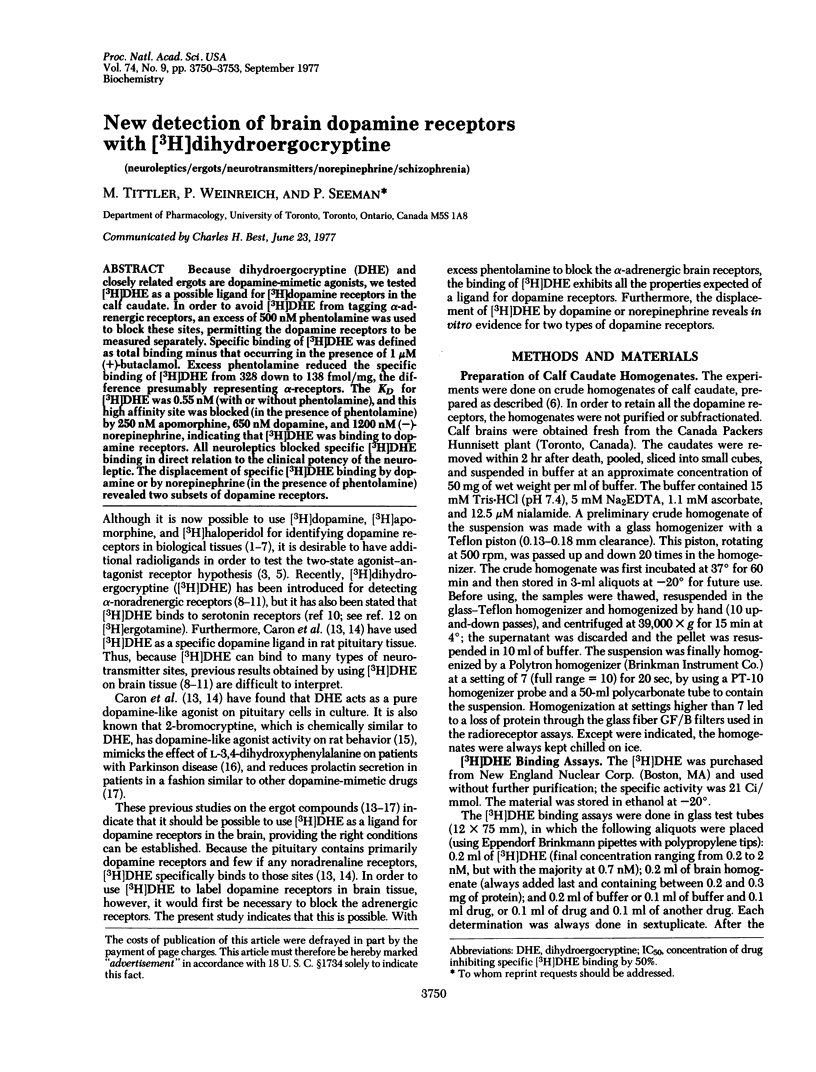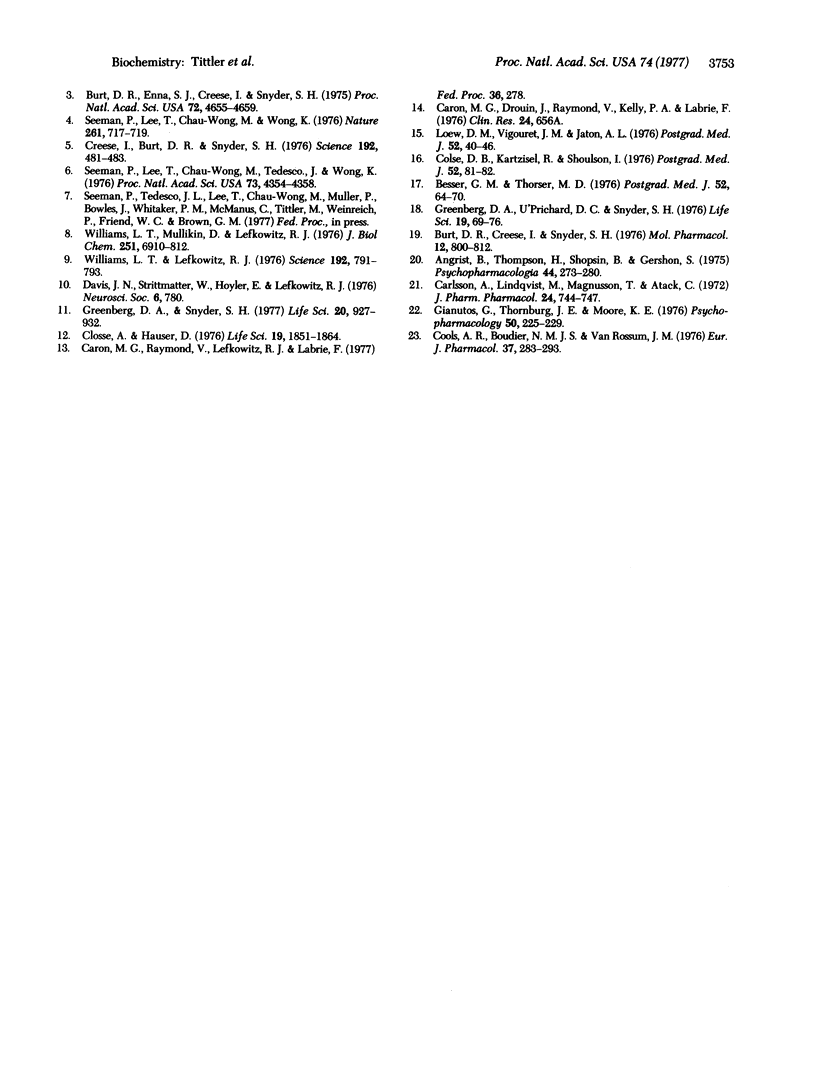Abstract
Because dihydroergocryptine (DHE) and closely related ergots are dopamine-mimetic agonists, we tested [3H]DHE as a possible ligand for [3H]dopamine receptors in the calf caudate. In order to avoid [3H]DHE from tagging alpha-adrenergic receptors, an excess of 500 nM phentolamine was used to block these sites, permitting the dopamine receptors to be measured separately. Specific binding of [3H]DHE was defined as total binding minus that occurring in the presence of 1 muM (+)-butaclamol. Excess phentolamine reduced the specific binding of [3H]DHE from 328 down to 138 fmol/mg, the difference presumably representing alpha-receptors. The KD for [3H]DHE was 0.55 nM (with or without phentolamine), and this high affinity site was blocked (in the presence of phentolamine) by 250nM apomorphine, 650 nM dopamine, and 1200 mM (minus)-norepinephrine, indicating that[3H]DHE was binding to dopamine receptors. All neuroleptics blocked specific [3H]DHE binding in direct relation to the clinical potency of the neuroleptic. The displacement of specific [3H]DHE binding by dopamine or by norepinephrine (in the presence of phentolamine) revealed two subsets of dopamine receptors.
Full text
PDF



Selected References
These references are in PubMed. This may not be the complete list of references from this article.
- Angrist B., Thompson H., Shopsin B., Gershon S. Clinical studies with dopamine-receptor stimulants. Psychopharmacologia. 1975 Nov 21;44(3):273–280. doi: 10.1007/BF00428906. [DOI] [PubMed] [Google Scholar]
- Besser G. M., Thorner M. O. Bromocriptine in the treatment of the hyperprolactinaemia-hypogonadism syndromes. Postgrad Med J. 1976;52SUPPL:64–70. [PubMed] [Google Scholar]
- Burt D. R., Creese I., Snyder S. H. Properties of [3H]haloperidol and [3H]dopamine binding associated with dopamine receptors in calf brain membranes. Mol Pharmacol. 1976 Sep;12(5):800–812. [PubMed] [Google Scholar]
- Burt D. R., Enna S. J., Creese I., Snyder S. H. Dopamine receptor binding in the corpus striatum of mammalian brain. Proc Natl Acad Sci U S A. 1975 Nov;72(11):4655–4659. doi: 10.1073/pnas.72.11.4655. [DOI] [PMC free article] [PubMed] [Google Scholar]
- Calne D. B., Shoulson I., Kartzinel R. An ergot derivative in the treatment of Parkinson's disease. Postgrad Med J. 1976;52SUPPL:81–85. [PubMed] [Google Scholar]
- Closse A., Hauser D. Dihydroergotamine binding to rat brain membranes. Life Sci. 1976 Dec 15;19(12):1851–1863. doi: 10.1016/0024-3205(76)90117-x. [DOI] [PubMed] [Google Scholar]
- Cools A. R., Boudier A. J., Rossum J. M. Dopamine receptors: selective agonists and antagonists of functionally distinct types within the feline brain. Eur J Pharmacol. 1976 Jun;37(2):283–293. doi: 10.1016/0014-2999(76)90036-4. [DOI] [PubMed] [Google Scholar]
- Creese I., Burt D. R., Snyder S. H. Dopamine receptor binding predicts clinical and pharmacological potencies of antischizophrenic drugs. Science. 1976 Apr 30;192(4238):481–483. doi: 10.1126/science.3854. [DOI] [PubMed] [Google Scholar]
- Gianutsos G., Thornburg J. E., Moore K. E. Differential actions of dopamine agonists and antagonists on the gamma-butyrolactone-induced in mouse brain dopamine. Psychopharmacology (Berl) 1976 Nov 24;50(3):225–229. doi: 10.1007/BF00426836. [DOI] [PubMed] [Google Scholar]
- Greenberg D. A., Prichard D. C., Snyder S. H. Alpha-noradrenergic receptor binding in mammalian brain: differential labeling of agonist and antagonist states. Life Sci. 1976 Jul 1;19(1):69–76. doi: 10.1016/0024-3205(76)90375-1. [DOI] [PubMed] [Google Scholar]
- Greenberg D. A., Snyder S. H. Selective labeling of alpha-noradrenergic receptors in rat brain with [3H]dihydroergokryptine. Life Sci. 1977 Mar 15;20(6):927–931. doi: 10.1016/0024-3205(77)90277-6. [DOI] [PubMed] [Google Scholar]
- Kehr W., Carlsson A., Lindqvist M., Magnusson T., Atack C. Evidence for a receptor-mediated feedback control of striatal tyrosine hydroxylase activity. J Pharm Pharmacol. 1972 Sep;24(9):744–747. doi: 10.1111/j.2042-7158.1972.tb09104.x. [DOI] [PubMed] [Google Scholar]
- Loew D. M., Jaton A. L., Vigouret J. M. Neuropharmacological investigations with two ergot alkaloids, Hydergine and bromocriptine. Postgrad Med J. 1976;52SUPPL:40–46. [PubMed] [Google Scholar]
- Seeman P., Chau-Wong M., Tedesco J., Wong K. Brain receptors for antipsychotic drugs and dopamine: direct binding assays. Proc Natl Acad Sci U S A. 1975 Nov;72(11):4376–4380. doi: 10.1073/pnas.72.11.4376. [DOI] [PMC free article] [PubMed] [Google Scholar]
- Seeman P., Chau-Wong M., Tedesco J., Wong K. Dopamine receptors in human and calf brains, using [3H]apomorphine and an antipsychotic drug. Proc Natl Acad Sci U S A. 1976 Dec;73(12):4354–4358. doi: 10.1073/pnas.73.12.4354. [DOI] [PMC free article] [PubMed] [Google Scholar]
- Seeman P., Lee T., Chau-Wong M., Wong K. Antipsychotic drug doses and neuroleptic/dopamine receptors. Nature. 1976 Jun 24;261(5562):717–719. doi: 10.1038/261717a0. [DOI] [PubMed] [Google Scholar]
- Williams L. T., Lefkowitz R. J. Alpha-adrenergic receptor identification by (3H)dihydroergocryptine binding. Science. 1976 May 21;192(4241):791–793. doi: 10.1126/science.4894. [DOI] [PubMed] [Google Scholar]


